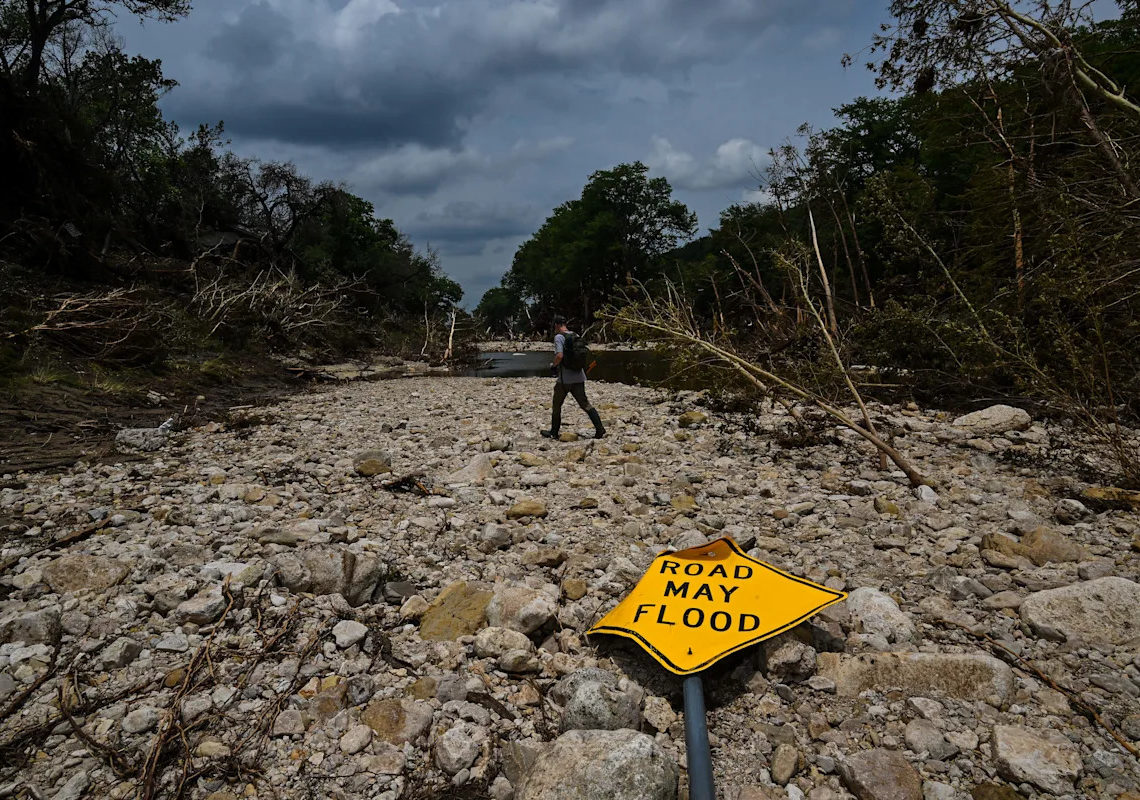Augustus Doricko knew when he founded a cloud-seeding start-up in 2023 that he’d have to contend with misunderstandings and conspiracy theories surrounding the technology. Still, he wasn’t quite prepared for the sheer volume of online fury he has faced in the wake of the catastrophic Texas floods that have killed more than 100 people and nearly twice that many missing.
“It has been nonstop pandemonium,” Doricko said in a phone interview Wednesday.
Doricko and his company, Rainmaker, have become a focal point of posts spiraling across social media that suggest the floods in Kerr County were a human-made disaster. An array of influencers, media personalities, elected officials and other prominent figures – including Rep. Marjorie Taylor Greene (R-Georgia) and former Trump adviser Michael Flynn – have publicly raised the possibility that cloud-seeding operations like Rainmaker’s might have caused or at least exacerbated the historic deluge.
That’s impossible, atmospheric scientists say. Cloud seeding, in which planes scatter dust particles through clouds to trigger rain and snow, remains a fledgling technology, the effects of which are too limited and localized to produce anything remotely like the 15 inches of rain that drowned swaths of South Central Texas over the Fourth of July weekend.
“The amount of energy involved in making storms like that is astronomical compared to anything you can do with cloud seeding,” said Bob Rauber, a University of Illinois at Urbana-Champaign atmospheric science emeritus professor who has studied the technology. “We’re talking about a very small increase on a natural process at best.”
That hasn’t stopped conspiracy theorists from latching onto cloud seeding as an incendiary explanation for natural disasters. The search for a scapegoat has turned a spotlight on a controversial technology that has drawn interest from drought-stricken Western states and dozens of countries looking to replenish water reservoirs, despite limited evidence that it works and broader social and environmental concerns about altering the weather. And it underscores how conspiracy theories can flourish in the aftermath of natural disasters as people seek information – and the clout that can come from providing sensational answers.
This much is true: On the afternoon of July 2, a single-engine plane operated by the El Segundo, California-based start-up Rainmaker flew on a cloud-seeding job over Runge, Texas, more than 100 miles southeast of Kerr County. Over the course of about 20 minutes, it released about 70 grams of silver iodide into a pair of clouds; the mission was followed by a modest drizzle that dropped less than half a centimeter of rain over the parched farms below, Doricko said.
The run was part of a contract that Rainmaker had inked this spring with the South Texas Weather Modification Association, a nonprofit funded by local water management districts to refill water reservoirs and boost rainfall over cropland.
Soon after, Doricko said, his company’s meteorologists saw a storm front approaching and called off their operations in the area. By the morning of July 4, the remnants of Tropical Storm Barry had dumped up to 15 inches of rain over parts of Kerr County.
But online sleuths steeped in conspiracy theories seized upon the coincidence.
On July 5, as the toll of dead and missing mounted, verified accounts on social media platform X demanded “accountability” as they circulated documents showing Rainmaker’s registration to perform weather modification projects in Texas.
“I’d love to see the response,” Flynn responded in a post that was viewed 1 million times.
Greene, who drew widespread rebukes last year when she implied that Hurricane Helene may have been engineered, posted Saturday on X that she was introducing a bill that would make attempts to alter the weather “a felony offense.” Her post drew 18 million views.
TikTok influencers posted clips from a recent interview on a podcast hosted by former Navy SEAL Shawn Ryan, with whom Doricko described his company’s work and discussed whom would be held responsible if it went awry. Some videos juxtaposed Doricko’s words with footage of the devastation in Texas or spliced them with an ominous cinematic score.
Doricko felt an air of inevitability as his mentions in recent days piled up with questions, accusations and threats. “I always anticipated that a moment like this would happen,” he said in an interview. “Basically every time there’s been severe weather somewhere in the world, people have blamed weather modification.”
Similar rumors emerged online after nearly two years’ worth of rain deluged Dubai last year.
He tried to shrug off the threats while patiently fielding more earnest questions, joining live audio events on X to explain cloud seeding’s capabilities and limitations.
But he pushed back on posts on X that showed pictures of the outside of Rainmaker’s office and posted its address. Doricko said Wednesday that X ultimately removed the posts and that he and his employees have not suffered any direct harm.
While there’s no evidence that cloud seeding played any role in the Texas floods or other recent natural disasters, such hypotheses can resonate with people seeking answers in a “chaotic” information landscape, said Holly Buck, an associate professor of environment and sustainability at the University at Buffalo.
The cloud-seeding theories tap into online subcultures that have grown up around the notion that what appear to be contrails – white streaks of condensation left by airplanes against the backdrop of blue skies – may be “chemtrails” of nefarious projects to alter the weather or poison the populace. Those communities flourished alongside conspiracies about bioweapons and vaccines during the covid-19 pandemic, Buck said, as public trust in the mainstream media and scientific expertise diminished.
Then there’s the fact that some governments really are trying to modify the weather.
At least 39 countries have cloud-seeding programs, according to a December report from the U.S. Government Accountability Office. China has invested at least $2 billion since 2014. Saudi Arabia spent more than $250 million on cloud seeding in 2022 alone, according to the report, and the United Arab Emirates and India have invested millions of dollars more in recent years.
While 10 U.S. states have proposed or passed laws banning cloud seeding, nine in the West – amid the worst droughts some areas have seen in 1,200 years – spend millions of dollars a year to squeeze rain or snow out of clouds. Utah leads the pack, with a $5 million annual cloud-seeding budget.
Research on cloud seeding is limited, according to the GAO report. But a 2017 research project in Idaho used high-tech radar to track silver iodide particles as they entered clouds, caused ice crystals to form and created snowfall, demonstrating that winter cloud seeding can create a small but noticeable increase in precipitation – something like a fraction of a millimeter of extra snow in a single event.
Over the course of an entire winter, small snow boosts can add billions of extra gallons of water to dwindling water reservoirs, according to Rauber, who was involved in the Idaho project.
Modern cloud seeding uses techniques the federal government first tried in the 1940s to boost rainfall and disrupt severe storms. Government scientists spent millions of dollars over decades tinkering with clouds.
In the 1960s, the Defense Department secretly tried to induce rainfall to wash out North Vietnamese supply routes – a campaign revealed by the New York Times in 1971 and acknowledged by the U.S. government three years later.
In another infamous instance, Air Force pilots sprinkled dry ice into a hurricane drifting over the Atlantic Ocean in 1947 to see if they could disrupt its formation; instead, the hurricane abruptly turned toward land, strengthened and caused one death and $2 million in damage, prompting public outcry. The deadly shift was a coincidence, Rauber said, but it taught scientists they should avoid any appearance of causing a disaster.
“Companies that do this type of stuff have to be very careful. When it looks like there’s going to be a large storm, you just don’t do it. You stay away from it,” Rauber said.
The federal government “pretty much” ended its cloud-seeding experiments in the 1980s, he said.
But some investors have backed companies like Rainmaker, which has raised $31 million in venture capital and employs 58 people, Doricko said. Even amid this week’s controversy, he said, he has gotten inquiries from potential clients who are just learning about cloud seeding.
Doricko said he understands why people are concerned about cloud seeding and believes careful regulation, oversight and transparency will be needed to build trust. His frustration is with the online influencers trying to assign blame for a natural disaster.
“If we lived in a world where you could hold someone to account, then theoretically you could stop them,” he said. “It’s a much more tragic world, and hard-to-deal-with world, if these things just happen because of nature and we have to deal with these tragedies.”
Related Content
How conservatives beat back a Republican sell-off of public lands
Gabbard’s team has sought spy agency data to enforce Trump’s agenda
Arthur Ashe’s knack for reinvention led him to history at Wimbledon
The post He seeded clouds over Texas. Then came the conspiracy theories. appeared first on Washington Post.



